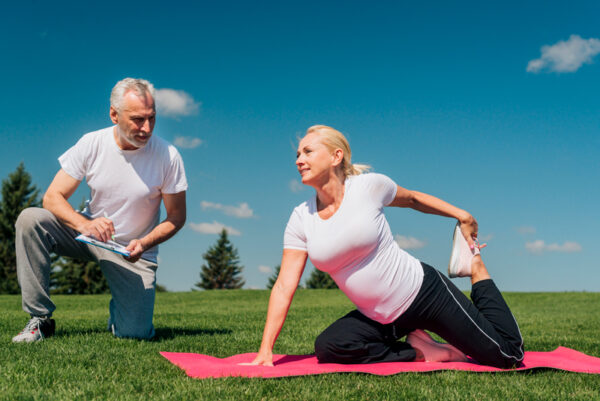
In an age where digital screens dominate our lives, it’s easy to forget the allure of the great outdoors. Yet, stepping outside, especially for physical activity, can transform our health in ways that indoor exercise simply cannot match. This blog post explores the compelling benefits of outdoor exercise, reinforcing the idea that the world outside your door is not just a backdrop for fitness but a dynamic setting that enhances physical and mental well-being.
1. Boosted Vitamin D Levels
One of the most immediate benefits of exercising outdoors is the natural intake of Vitamin D, courtesy of the sun. This critical nutrient plays a vital role in bone health, immune function, and mood regulation. Unlike indoor environments, where exposure to natural light is limited, outdoor activities provide an ample amount of Vitamin D, which many adults often lack.
2. Enhanced Mood and Reduced Stress
Nature has a profound effect on our mental health. Studies consistently show that spending time outdoors decreases stress and can significantly lower symptoms of anxiety and depression. The combination of natural light, fresh air, and the serene sounds of nature acts as a natural stress reliever. Furthermore, outdoor exercise can increase self-esteem and reduce negative thoughts, providing a mental health boost unmatched by the gym environment.
3. Improved Concentration and Creativity
Exercising in a natural environment not only benefits the body but also the mind. The varied and stimulating landscapes can enhance focus and creativity. A research study found that walking in nature, as opposed to walking in urban settings, resulted in improved performance on tasks requiring attention and creative problem-solving. This cognitive benefit underscores the value of green spaces for mental rejuvenation and productivity.
4. Increased Motivation and Enjoyment
The diversity of outdoor settings can significantly impact motivation levels and the overall enjoyment of the exercise routine. Engaging in physical activity in a visually appealing environment feels less like a chore and more like a rewarding experience. The natural variety and changing scenery can also keep workouts exciting and prevent the boredom often associated with indoor workouts.
5. Greater Caloric Burn
Outdoor exercise, particularly in varied terrains such as hills or uneven trails, requires the body to adapt to the changing environment. This not only improves balance and agility but also increases the amount of energy expended. Factors such as wind resistance and temperature fluctuations also contribute to higher caloric burn compared to exercising indoors, making outdoor activities an efficient choice for those aiming to manage weight or improve fitness levels.
6. Building a Community Connection
Outdoor exercise often involves communal spaces like parks, trails, or beaches, encouraging interactions with fellow fitness enthusiasts. This can lead to a sense of community and social belonging, which is beneficial for mental health. Joining outdoor fitness classes or groups provides accountability, enhances commitment to physical activity, and offers the chance to form supportive relationships centered around health and wellness.
7. Cost-Effective and Accessible
Lastly, the great outdoors is an accessible and cost-effective gym alternative. Nature’s gym comes free of charge, without memberships or fees. Whether it’s a city park, a hiking trail, or your neighborhood streets, outdoor spaces provide a versatile venue for a wide range of physical activities, from walking and jogging to cycling and yoga.
The Takeaway
The benefits of outdoor exercise extend far beyond the physical, offering comprehensive enhancements to emotional and mental well-being. In our quest for fitness and health, it’s crucial to leverage the natural world’s restorative powers. As we uncover the layers of benefits associated with outdoor activity, it becomes clear that integrating nature into our fitness routines is not just beneficial—it’s essential.
Incorporating outdoor exercise into your lifestyle doesn’t require drastic changes; a simple walk in the park or an occasional outdoor yoga session can make a significant difference. The key is to step outside and allow nature to do its work. With every breath of fresh air and step on natural ground, you’re not just working toward a fitter body, but also a happier, healthier mind.
Afraid to get started on your own or don’t know how to navigate this new activity? Here’s a few tips:
- Start slowly, set realistic goals for the length of time you exercise
- Listen to your body, if it hurts, stop or change what you are doing
- Find a friend to get outdoors with
- Make an appointment with yourself so you ensure you get outside
- Warm up – stretches (both dynamic and static) are helpful – check out other blogs on our page about stretching!
If you experience any pain or difficulty, please consult your Healthcare Provider before continuing.
A Physical Therapist is a movement specialist and we are the pro’s to help determine the best course of action to get your outdoor activity going. Together with the proper activity progression, accounting for your specific movement needs, we can help create that bond of the physical and mental well-being benefits of outdoor exercise. We can help!
Keep Reading…
Daily Stretching | A Guest Blog by Mallory Wisniewski Fitness
A Guest Blog By Mallory Wisniewski 300HR CYT & [...]
Spring into Action | Changes in Weather Change Your Activity Level
Spring is in the air, meaning more than just [...]
Sticking To Your Exercise Program | How To Not Fall Off The Treadmill (or Bike, or Rower…)
New Year's resolutions around fitness and exercise are incredibly [...]
10 Tips To Help You Get Up & Get Your Workout Done In The Morning
Are you struggling to peel yourself away from the [...]
5 Core Exercises For A Healthy Back
A strong core is essential for good posture, balance, [...]
The Health Benefits of Walking. You Might Be Surprised
Regular exercise vital is for maintaining good health. I've [...]







